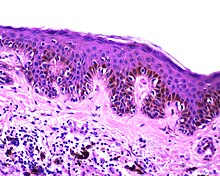
Back شامة ميلانينية Arabic Бенка Bulgarian Nevus melanocític Catalan Pigmentnävus German Σπίλος Greek Nevo melanocítico Spanish Nebo melanozitiko Basque Ball dobhráin Irish Ball-dòbhrain Scots/Gaelic Tahi lalat ID
| Melanocytic nevus | |
|---|---|
 | |
| Lentiginous melanocytic naevus | |
| Specialty | Dermatology |
A melanocytic nevus (also known as nevocytic nevus, nevus-cell nevus and commonly as a mole)[1][2] is usually a noncancerous condition of pigment-producing skin cells. It is a type of melanocytic tumor that contains nevus cells.[2] Some sources equate the term mole with "melanocytic nevus",[2] but there are also sources that equate the term mole with any nevus form.[3]
The majority of moles appear during the first two decades of a person's life, with about one in every 100 babies being born with moles.[4] Acquired moles are a form of benign neoplasm, while congenital moles, or congenital nevi, are considered a minor malformation or hamartoma and may be at a higher risk for melanoma.[4] A mole can be either subdermal (under the skin) or a pigmented growth on the skin, formed mostly of a type of cell known as a melanocyte. The high concentration of the body's pigmenting agent, melanin, is responsible for their dark color. Moles are a member of the family of skin lesions known as nevi, occurring commonly in humans.[3][4]
- ^ James, William D.; Berger, Timothy G.; et al. (2006). Andrews' Diseases of the Skin: clinical Dermatology. Saunders Elsevier. ISBN 0-7216-2921-0.
- ^ a b c Albert, Daniel (2012). Dorland's illustrated medical dictionary (32nd ed.). Philadelphia, PA: Saunders/Elsevier. p. 1173. ISBN 978-1-4160-6257-8.
- ^ a b "Moles". Mayo Clinic. 18 February 2022. Retrieved 5 June 2023.
- ^ a b c "What are moles?". American Academy of Dermatology. 2023. Retrieved 5 June 2023.
© MMXXIII Rich X Search. We shall prevail. All rights reserved. Rich X Search